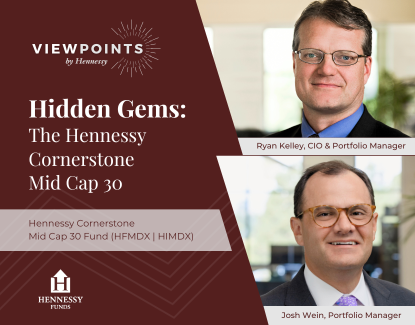High Profitability and Attractive Valuations – A Compelling Combination
In the following commentary, the Portfolio Managers of the Hennessy Cornerstone Large Growth Fund discuss the Fund’s formula-based investment process and how it drives the Fund’s sector and industry positioning.
-
 Neil J. HennessyChief Market Strategist and Portfolio Manager
Neil J. HennessyChief Market Strategist and Portfolio Manager -
 Ryan C. Kelley, CFAChief Investment Officer and Portfolio Manager
Ryan C. Kelley, CFAChief Investment Officer and Portfolio Manager -
 L. Joshua Wein, CAIAPortfolio Manager
L. Joshua Wein, CAIAPortfolio Manager
What is the Hennessy Cornerstone Large Growth Fund’s investment strategy?
The Fund utilizes a formula-based approach in building a portfolio of attractively valued, highly profitable, larger-cap companies. In essence, the strategy seeks high quality, high return companies that may be overlooked by investors. From the universe of stocks in the S&P Capital IQ Database, the Fund selects the 50 stocks with the highest one-year return on total capital which also meet the following criteria, in the specified order:
» Above-average market capitalization
» Price-to-cash flow ratio less than the median of the remaining securities
» Positive total capital
Why does the Fund use these screening criteria?
Larger market capitalization companies tend to be well-established leaders in their industries with long, successful track records and solid profitability.
A low price-to-cash flow ratio can be a good indicator of attractive stock valuation. Positive cash flow tends to be associated with companies with profitable business models.
The use of positive total capital as a screening criterion helps the Fund avoid financially weaker companies.
Why does the formula select stocks with the highest one-year return on total capital?
From among the companies that meet the screening criteria, the Fund selects the 50 with the highest one-year return on total capital. We believe return on total capital is an excellent measure of a company’s profitability and is often associated with strong management, high barriers to entry, and other favorable attributes. As a result, we believe this measure can help uncover stocks with the potential to outperform the market.

How does the Fund seek to provide a return to investors?
We believe the Fund’s investments present the potential for capital appreciation when and if market sentiment changes and their valuations rise. Strong profitability has the potential to lead to earnings growth, which could also drive capital appreciation.
How often does the Fund rebalance its portfolio?
The universe of stocks is re-screened and the portfolio is rebalanced annually, generally in the winter. Holdings are weighted equally by dollar amount with approximately 2% of the Fund’s assets invested in each during the rebalance.
How does the Fund’s portfolio differ from its benchmark?
Almost 60% of the Fund is invested in the Industrials, Consumer Discretionary, and Consumer Staples sectors. Compared to its benchmark, the Russell 1000® Index, the Fund is most significantly overweight Industrials and Consumer Staples. The Fund is invested across eight of the 11 GICS sectors, with the exception of Communication Services, Real Estate and Utilities.
Companies in the portfolio could benefit from a strong overall economy, characterized by investment in construction and housing, strong profits from oil & gas exploration and production companies, and strong trends in consumer spending. Industrial stocks are potentially well-positioned for a strong upcycle, driven by infrastructure spending, onshoring of manufacturing, and ongoing investments in digital transformation and sustainability initiatives. As the economy continues to grow, companies in the aerospace, defense, logistics, and building products sectors are likely to benefit. Consumer stocks may see positive performance as consumers, buoyed by a robust labor market and rising wages, are likely to increase spending on both essential and nonessential goods and services. While politics and policy will affect companies in the portfolio, either negatively or positively, we continue to see value in investing for the long-term based on fundamentals and not on fluctuating and unpredictable trends.

- In this article:
- Domestic Equity
- Cornerstone Large Growth Fund
You might also like
-
 Portfolio Perspective
Portfolio Perspective
Cornerstone Value FundDriven by Revenues, Cash Flow, and High Dividend Yields
 Neil J. HennessyChief Market Strategist and Portfolio Manager
Neil J. HennessyChief Market Strategist and Portfolio Manager Ryan C. Kelley, CFAChief Investment Officer and Portfolio Manager
Ryan C. Kelley, CFAChief Investment Officer and Portfolio Manager L. Joshua Wein, CAIAPortfolio ManagerRead the Commentary
L. Joshua Wein, CAIAPortfolio ManagerRead the CommentaryIn the following commentary, the Portfolio Managers of the Hennessy Cornerstone Value Fund discuss the Fund’s formula-based investment strategy and how it drives the Fund’s sector and industry positioning.
-
 Portfolio Perspective
Portfolio Perspective
Focus FundLong-term Investing in a Concentrated Collection of Businesses
 David Rainey, CFACo-Portfolio Manager
David Rainey, CFACo-Portfolio Manager Ira Rothberg, CFACo-Portfolio Manager
Ira Rothberg, CFACo-Portfolio Manager Brian Macauley, CFACo-Portfolio ManagerRead the Commentary
Brian Macauley, CFACo-Portfolio ManagerRead the CommentaryIn the following commentary, the Portfolio Managers of the Hennessy Focus Fund summarize the 2024 market and provide their insights on their 2025 outlook, including the impact on holdings from presidential administration’s policy changes and the growth of AI.
-
 Viewpoint
ViewpointHidden Gems: The Hennessy Cornerstone Mid Cap 30
 Ryan C. Kelley, CFAChief Investment Officer and Portfolio Manager
Ryan C. Kelley, CFAChief Investment Officer and Portfolio Manager L. Joshua Wein, CAIAPortfolio ManagerWatch the Video
L. Joshua Wein, CAIAPortfolio ManagerWatch the VideoLearn more about the Hennessy Cornerstone Mid Cap 30 Fund, a top-performing strategy that uses a transparent, consistent, disciplined approach to identify undervalued mid and small-cap companies. Portfolio Managers Ryan Kelly and Josh Wein explain their time-tested formula and discuss why it consistently outperforms the market.
